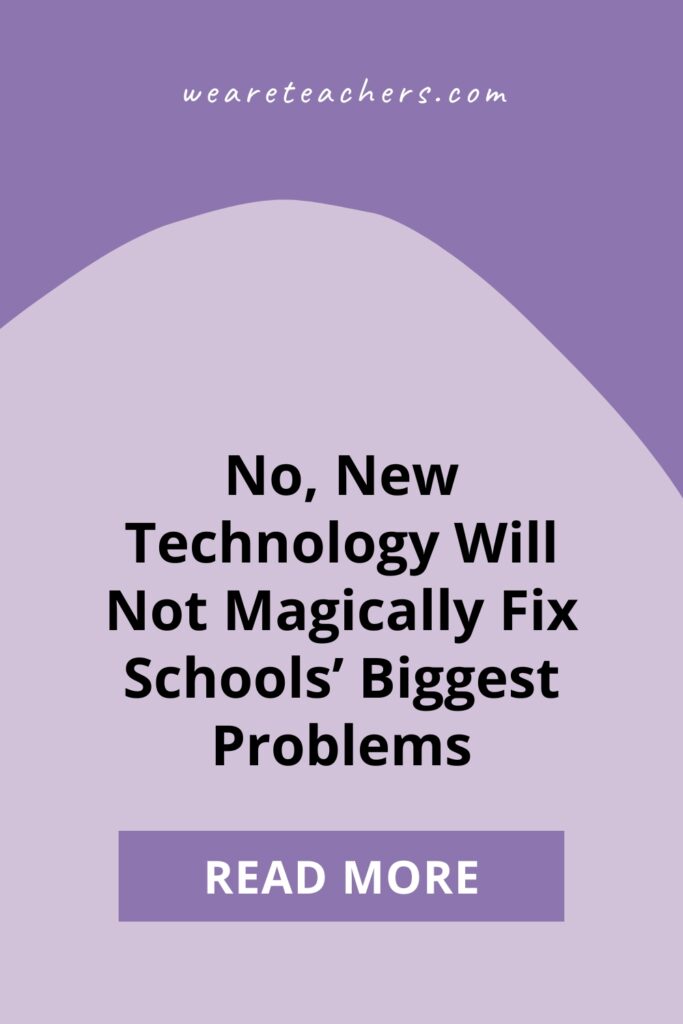Technology can fix a lot. But technology can’t fix everything.
We’ve all witnessed it: administrators swooping in with shiny gadgets and flashy new systems, promising to solve our most pressing problems with a quick fix.
But deep down, we all know relying on expensive technology alone won’t mend the underlying challenges we face in our classrooms. It’s time we shed some light on this pervasive technology Band-Aid mentality and advocate for meaningful solutions that actually get at the root cause of issues.
Let’s dive into these top 10 unsettling trends of technology quick fixes proposed by districts.
10 “Magic Wand” Myths About Technology We No Longer Believe
1. Smart boards will boost low test scores
Once hailed as a solution for low test scores, Smart boards promised to revolutionize classrooms and engage students—or at least what we heard as rural or international schools. However, it’s important to acknowledge that simply introducing this technology cannot address the root causes of academic struggles.
What would help: To genuinely improve academic performance, districts must take a comprehensive approach by investing in teacher professional development, updating the curriculum with problem-solving content, and providing targeted student support. Smart boards are not a cure-all—real progress requires a multifaceted approach.
2. Cameras will eliminate discipline complaints
While implementing surveillance cameras could decrease major safety issues, let’s be real: They won’t magically solve the day-to-day discipline issues teachers face in their classrooms. The presence of a camera won’t necessarily prevent misbehavior or give administrators the backbone they need to support teachers in disciplinary matters. Cameras can only address the result of misbehavior, not the cause.
What would help: A better solution lies in establishing clearer communication between administrators and teachers, fostering relationships within the community, and providing professional development on innovative approaches to discipline. Plus, more substantial administrative support is needed when it comes to discipline.
3. School management systems will keep students accountable
Ever heard about how researchers hail data-driven schools as the ultimate solution? Implementing a school management system to streamline processes and magically engage students sounds enticing, right? Well, it’s not that simple.
What would help: Our professional degrees have taught us effective strategies for reaching apathetic students, and districts could take a page from our playbook. Connecting with students beyond the curriculum, offering them choices, encouraging creativity, providing regular check-ins, and being consistent are the real ways to combat student apathy. None of these strategies have anything to do with a streamlined school management system.
4. Issuing 1:1 technology will save education
Amid the post-COVID-19 transition to 1:1 technology in schools, districts burden teachers with another responsibility. Juggling our tech needs is already challenging, and we must handle 20 kindergartners’ Chromebooks too. Talk about overwhelming! Here’s the thing: Some districts believe that providing teachers with the latest and greatest personal technology will somehow make us forget about the challenges of managing each student’s tech issues.
What would help: Districts should consider hiring more technology professionals or providing more professional development for teachers to learn quick fixes for Chromebook or iPad issues. Districts should also adopt a comprehensive technology plan that includes regular updates, maintenance, and technical support.
5. Getting new technology will improve low morale and school culture
Picture this: You walk into your classroom the day after installing the newest, shiniest toys. It’s a nice gesture, but an assistant principal passes by with a forced smile, unaware of your first name. Let’s get real here—giving us fancy gadgets won’t magically fix the deeply rooted low morale in school buildings. The truth is administrators themselves can make or break school culture.
What would help: Addressing low morale and improving school culture requires a commitment to meaningful teacher appreciation and support. Instead of relying on new toys, addressing poor school culture means listening to teachers’ opinions, being skilled planners, practicing empathetic listening, and genuinely caring about their teachers’ strengths and talents. Teachers want to feel like they belong and are involved in their school culture, not just receive new toys and awkward, tight-lipped smiles.
6. Online learning platforms will fix the teacher shortage
Have you ever found yourself overflowing with students in a classroom or tutoring session, resorting to an online learning platform as the only means to manage the chaos? It’s disheartening to think about how much better it would be for our students if additional teachers were available to provide personalized instruction instead of relying solely on impersonalized learning tools.
What would help: While districts aren’t always at fault for teacher shortages, expecting teachers to take on more responsibilities with the same pay while relying on online platforms is not a suitable substitute for well-trained, adequately compensated educators. If possible, districts should invest in recruitment strategies that attract talent, provide competitive teacher salaries, and provide opportunities for career advancement.
7. Online gamification as a cure-all for student motivation
Children are naturally drawn to games! It may seem tempting to employ gamification tools to ignite their motivation and cultivate a love for school. While gamification can capture initial interest and excitement, true motivation and a genuine passion for learning don’t rely on external rewards.
What would help: Students today are in crisis, and it’s not because we need to make school more fun. Districts could focus on fostering meaningful connections with students and empowering teachers to create relevant learning experiences that resonate with their students’ interests and aspirations.
8. Virtual-reality goggles will remedy student engagement
Sometimes when I hear schools getting virtual reality (VR) goggles for their students, I think, “Wow, what school can afford that nice piece of technology?” While VR can certainly provide immersive experiences (aside from the suggested use limit), it is not a cure-all for the lack of student engagement. In fact, we suspect there are far more serious issues at play in widespread student apathy.
What would help: Districts should prioritize investing in authentic learning experiences outside the classroom. Genuine engagement stems from meaningful and relevant learning experiences that resonate with students’ interests and encourage active participation. There is no replacement for actual field trips and real human connections.
9. Data analytics platforms = personalized learning
While the idea of a digitized learning platform that identifies students’ gaps and motivates them to address those gaps may sound appealing, we must be realistic about its effectiveness. Understanding students’ unique strengths, interests, and learning preferences requires more than just relying on an analytics platform.
What would help: Districts should truly value teachers’ crucial role in reaching and teaching students, addressing their individual gaps, and forming meaningful connections. Teachers’ expertise and personalized guidance are essential in fostering student growth and creating a supportive learning environment.
10. Social media campaigns will improve schools’ reputations
And I saved my personal favorite for last. Do districts genuinely believe that pouring substantial money into resources for their social media or marketing will help the schools’ reputations? And effective marketing will magically improve their schools’ reputation? Will focusing solely on their appearance on social media fix everything without actually addressing the issues they have for their students? Nope. Just another Band-Aid.
What would help: Districts should prioritize making direct improvements within their school buildings, such as ensuring quality teaching, providing robust student support, and fostering positive school climates. Proactive communication with parents, students, and the community can help build real connections within the school.
Overall, districts need to know that, on its own, technology can’t fix the challenges teachers face. While technology may provide temporary excitement, it fails to address complex issues that demand more meaningful approaches. These superintendents insist that school climate surveys and genuinely wanting to hear feedback from teachers are ways to improve low teacher morale and poor building cultures. By investing time and effort in creating environments where teachers feel a sense of belonging and have a voice, districts can create better educational environments for teachers and students.
What other technology promises do you no longer believe? Tell us in the comments!
For more articles like this, be sure to subscribe to our newsletters.


